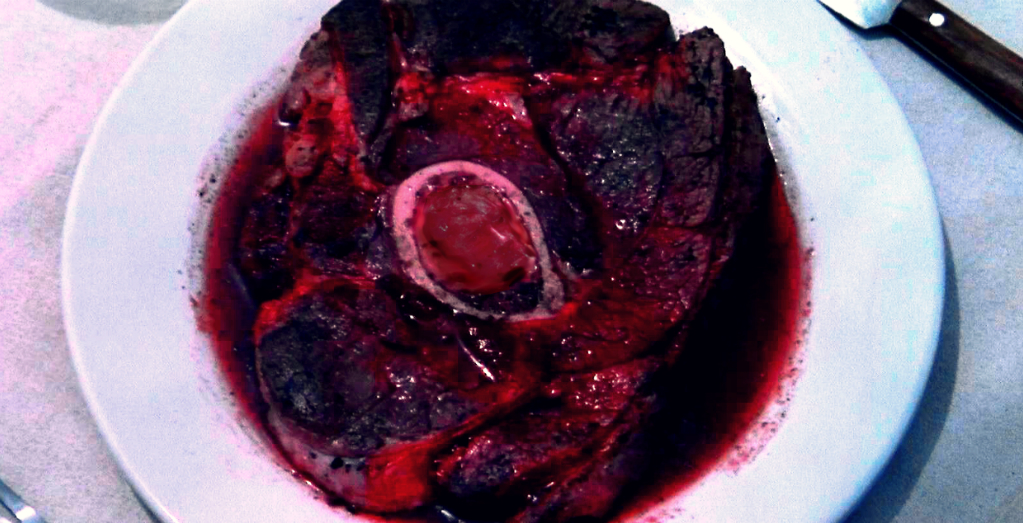
|Betsy Midnight|
Flash yourself back to 1999: the shiny Clinton years had fully dissolved into scandal, boy bands couldn’t be stopped, The Matrix came out, and everyone started wearing pleather trench coats with their platform flip-flops. Into this kooky transitional period in American culture, Ravenous––a surprisingly artsy, horror Western––poofed into theaters with a smirk. Sadly, no one noticed. Looking back, it was really the wrong time for this movie to come out. But in the 20 years since its release, the film’s unique combination of gore, suspense, and humor––with an eyebrow raised to the macabre underbelly of the human condition and a decisively stylistic flourish––has established a cult following that has grown slowly but with real commitment.
The film centers on the mythological Wendigo, a cannibalistic monster of insatiable hunger, and it is wrapped in the grimy filth and fear of the isolated fringes of the American West in the 1840s. This setting, right in the middle of the bloody Manifest Destiny massacre century, yet still a full 20 years before the Civil War, calls to mind Heart of Darkness as it plunges deep into a moment in American history that was already soaked in wildness and violence, a time that was getting darker and more gruesome by the day. It’s a perfect moment in history for a cannibal tale, laced with both the desperation of The Donner Party and the grotesque giddiness of Delicatessen.
Far from the standard hero of the American Western, all guts and adventure and justice, our protagonist in Ravenous is a coward. We know little about Lieutenant Boyd (Guy Pearce) other than that he earned his exile because he decided to lay down in the dirt and pretend to be dead rather than fight alongside his dying comrades in the Mexican-American war. This isn’t a one-time thing with Boyd either. This isn’t a story about a coward who goes through a bunch of challenges and discovers his courage. Boyd is a scared guy, through and through, who is backed into a corner with a bunch of superhuman cannibals at the edge of the wilderness, trying to figure out how to survive. He is a man of few words who spends much of the film mumbling, staring into space, or cowering; at one point, he even gets so scared he jumps off a cliff! By contrast, Robert Carlyle’s Colqhoun is spritely and spirited, with a steady gaze, polished demeanor, and predatorial physicality. He clearly has every advantage in this showdown, and when his appetites flicker like candle-lit shadows over his features from time to time, it is genuinely frightening.
Though the conflict between the two main characters is strong, the fascinating strangeness of the filmis so much bigger than strong performances from its lead actors. As a whole, the movie feels like an accidental combination of very distinct but unrelated choices, likely thanks to studio mismanagement and creative team drama going on behind the scenes. The result should be disastrous or sloppy or incoherent––but miraculously, it works. The whole that these disparate parts create is cohesive and tight. For example, the film’s prologue––which quotes Nietzsche and “Eat me,” or the memorable first scene in which dozens of soldiers chow down on bloody steaks––blends the production value of a Hollywood historical drama with a dissociative mix of sound and visuals, similar to what you might find in an experimental or avant-garde film.
Perhaps the best example of this mash-up magic, however, is the film’s remarkable score, which combines the talents of two accomplished composers: Michael Nyman, famous for the emotionally sweeping orchestrals for films such as The Piano and Gattaca, and Damon Albarn, front-man of the Brit-pop band, Blur and principal songwriter for electronic/hip-hop animated band, Gorillaz.Throughout the film, a mystical motif of twangy, sparse sparks of plucked strings twinkles over layers of melodically dissonant flutes and compressed rhythms that pulse like a squeezebox filtered through a paper towel tube. This starting point flows just as easily into a goofy, Southern-style jig reminiscent of Yakety Sax as it does into the strained, tense strings of a traditional horror-suspense climax. Ravenous does both of these moves, and then it re-centers itself with a pulsing, methodical drone punctuated by twangy sparks to keep it grounded in the film’s 19th century setting. Albarn’s pop music acuity mixes with Nyman’s grandly sweeping cinematic instincts to produce an effect that is firmly planted in both Hollywood big-budget filmmaking trends and weirdo arthouse experimentation at the same time.
Thanks to a playful script and decisive direction, Ravenous skillfully nudges us to consider the allegorical implications of the hungry monster at its center without doing too much of the thinking on our behalf. Interestingly, Wendigo Psychosis is a real modern medical term grown from the myth, used to describe a condition in which a person has (and in some cases, acts on) an intense desire to murder people and eat them. Records of confirmed cases go back hundreds of years. Anthropologists and psychologists argued about whether this condition was a factual, historical phenomenon or a fabrication as recently as the 1980s. Hopefully they’ve put that argument to bed by now: whether or not you have human meat between your teeth, our species’ inclination to destroy others to feed individual appetites is definitely real. Heck, America was practically built on the idea.
Ravenous is in the same movie family as:
- Dead Man
- Anthropophagous
- Deliverance
- The Road
- Delicatessen
… and is playing at the Trylon from October 25 to October 27. Tickets and more information are available at trylon.org.
Edited by Michelle Baroody
